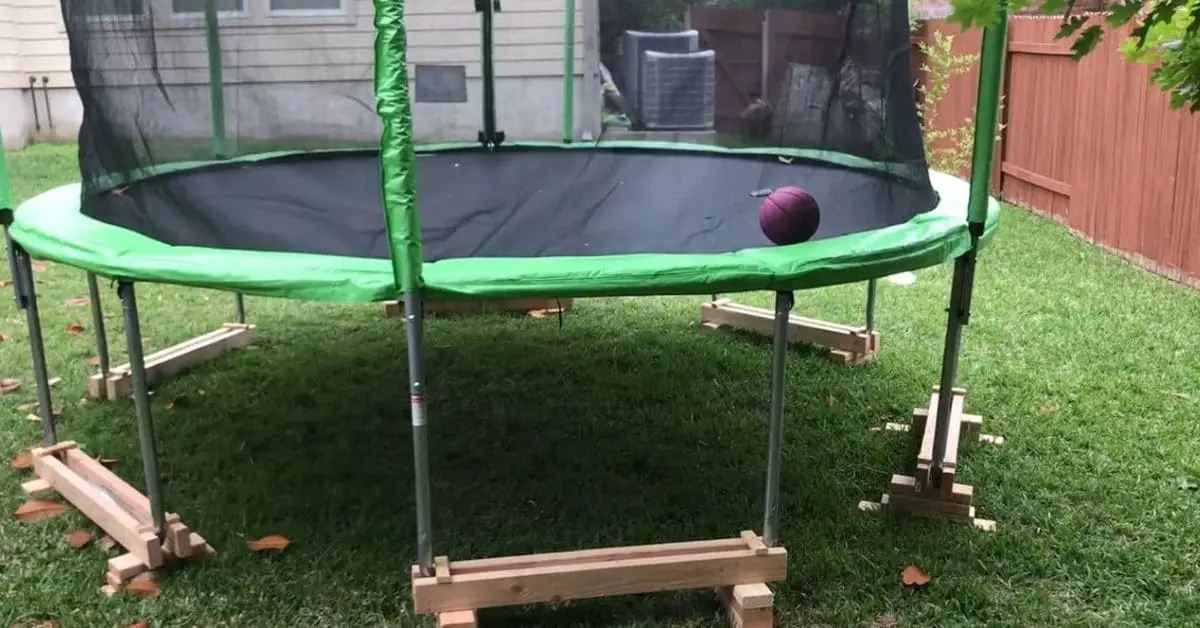I am here to guide you on how to level a trampoline on a slope. The first step is to gather all the necessary materials, including a level, shovel, and stakes. Once you’ve selected an appropriate location for your trampoline, clear the area of any debris or rocks that could interfere with the leveling process.
Use your level to determine the degree and direction of the slope, then excavate the ground on the high side to create a level base for the trampoline. With your trampoline in place, use the level to ensure it is perfectly level, and adjust the legs as needed.
Finally, secure the trampoline to the ground using anchors or stakes to prevent it from shifting or moving during use. Remember to check the trampoline periodically to ensure it remains level and secure, and follow safety guidelines to avoid injuries.
How to Level a Trampoline on a Slope: Use leveling blocks instead of standard ones for a stable trampoline, which can cause wobbling. Opt for an interlocking kit to avoid guesswork and get perfect results.
What is the significance of leveling a trampoline?
Leveling a trampoline is crucial if it is installed in a sloped or uneven area. This is important for safety reasons since the uneven ground can cause an unstable jump bed, resulting in an unsafe bounce and potential injuries. Moreover, the sloped floor can force jumpers towards the lower side, leading to an imbalanced landing.
Furthermore, if the trampoline is not leveled, the weight distribution will not be even, which can cause the springs and mat to wear and tear more quickly, damaging the trampoline.
How to Measure the Slope of Your Backyard?
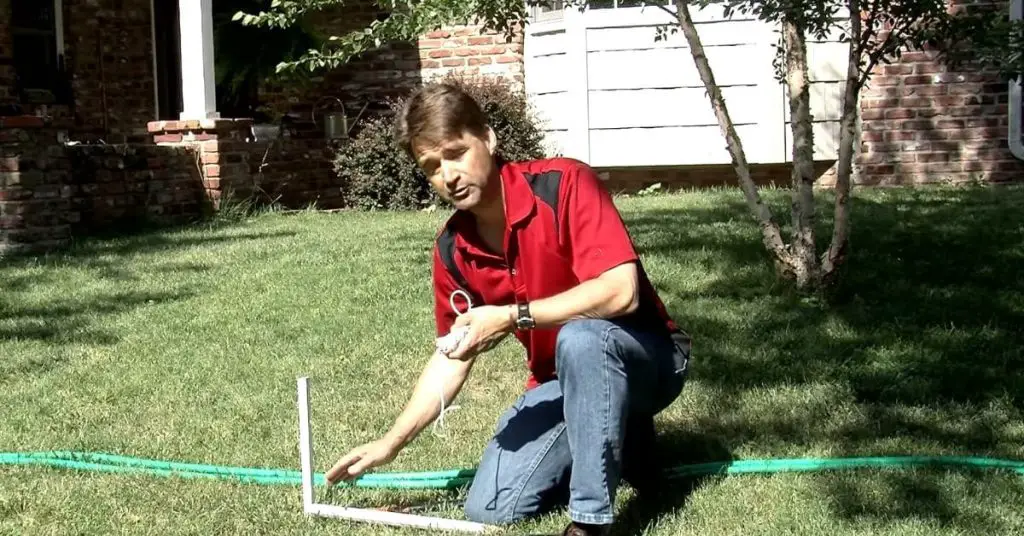
Before leveling your trampoline, you need to measure the slope of your backyard. You will need a wood plank, a carpenter’s level, and a measuring tape. First, place the trampoline in its desired permanent location and parallel the plank to the slope.
Place the carpenter’s level on top of the plank and lift the downward side of the plank. Check the bubble on the level and measure the distance between the plank and the trampoline on the low side.
Divide the trampoline diameter by this distance. If the result is over 7, the slope is too high, and you should find a different location. Once you have determined the hill, you can level the trampoline by raising the downward side in various ways.
What Tools and Accessories are Needed to Level a Trampoline on Uneven Ground?
You will need a few basic tools when setting up a trampoline on an uneven or sloped lawn. These include a tape measure to measure the distance between the ground and the trampoline legs, a carpenter’s or a laser level to ensure that the trampoline is even, and trampoline assembly tools such as a spring puller, hammer, gloves, and more.
You may also need a trampoline leveler or leveling kit to adjust the legs of the trampoline and make it level on uneven ground.
Installing a Trampoline on a Sloped or Uneven Ground or Hill:
Before installing a trampoline on a slope, measure the slope of the land. You can use a tape measure, a carpenter’s level, and a wood plank. Put the trampoline on the slope and place the plank on it.
Put the carpenter’s level on the plank and lift the lower side of the plank until the bubble is level. Measure the distance from the trampoline to the top of the plank.
Divide this distance by the trampoline diameter. If the slope is more than 7, it’s too steep and unsafe. Move the trampoline to a place with a lower pitch.
How to Level a Trampoline on a Slope: Step-by-Step Guide
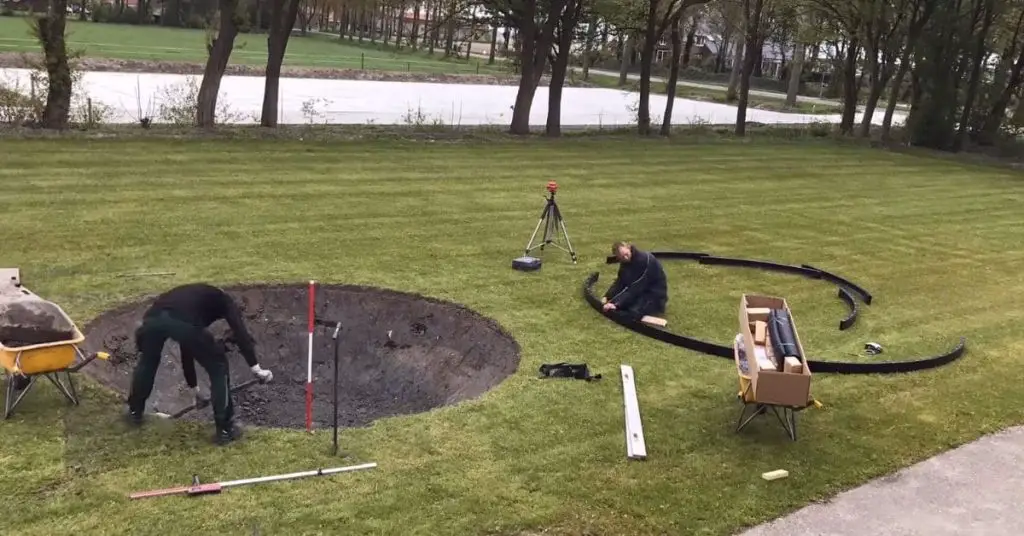
Here is a step-by-step guide on how to level a trampoline on a slope:
Add Soil on Down Side of Trampoline:
If you want to level a trampoline on a slope, one way is to raise the lower side of the trampoline by adding some material underneath it. This can be done using soil, sand, dirt, mulch, gravel, or bricks.
First, choose the material you want to use based on availability and suitability. Soil is a common choice as it’s usually available and easy to work with. However, sand or gravel may be a better option if you need more stability and less settling.
Next, you should spread the material evenly under the trampoline’s lower side until the trampoline is level. Pack the material firmly to ensure the trampoline is supported and doesn’t sink into the ground over time.
It’s important to note that you may need to add more material over time as it may shift or settle. Therefore, you should periodically check the trampoline’s level and adjust it to maintain a safe and enjoyable jumping experience.
Dig a Trench to Level Trampoline on a Slope:
Another way to level a trampoline on a slope is to dig a trench on the higher side to match the height of the lower side. To start, you need to determine the trench depth based on the slope’s angle and the trampoline’s diameter.
Once you have determined the depth, use a shovel to dig the trench on the slope’s upper side, ensuring it is leveled and wide enough to accommodate the trampoline legs.
Ensure the trench’s width is equal to the trampoline’s diameter or larger so that the trampoline legs fit comfortably.
After digging the trench, place the trampoline in the canal and check if the trampoline bed is level. If it’s not level, you may need to explore the trench deeper to achieve a level surface. Once you’re satisfied with the story of the trampoline, securely anchor the legs in the channel to prevent any movement.
The trench method is an effective way to level a trampoline on a slope, but it does require some manual labour. However, it’s a permanent solution that provides a safe and stable surface for the trampoline.
Cut the Legs of Trampoline to Level it on a Slope:
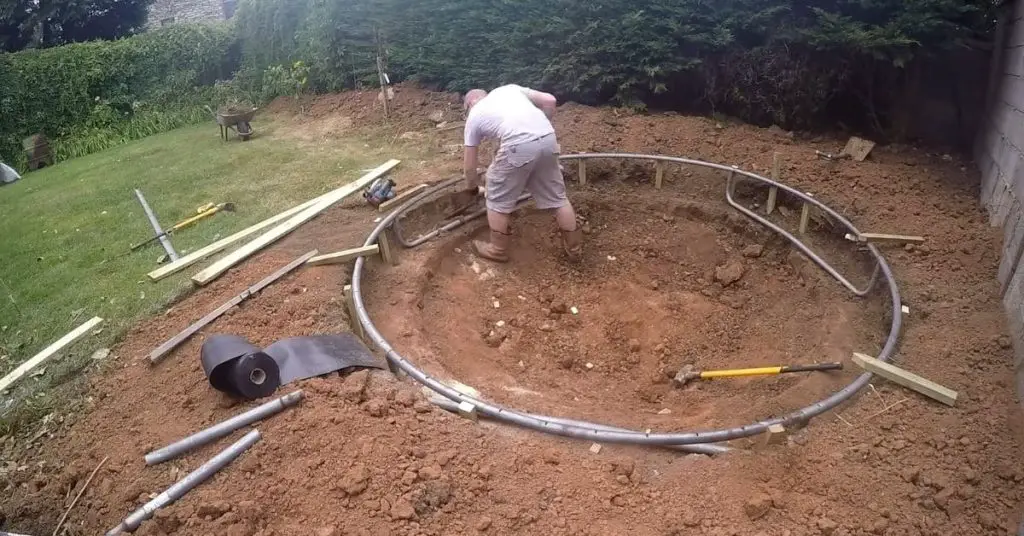
Cutting down the trampoline legs is not recommended unless it’s the only option. This method should only be used if you plan to permanently keep the trampoline in that location. If you decide to cut the legs, use a saw or hire a professional to do it for you.
Remember that this will make the trampoline shorter, so it might not be a good idea if you plan on using it in other locations.
Adjust Trampoline’s Legs to Level it on a Slope:
To level a trampoline, you can adjust the height of its legs by adding extra material to the lower side legs. You can also put some additional layers under the down-side legs.
A professional welder can help you with this task. Although trampolines don’t come with adjustable legs, you can customize the legs’ height to meet your needs.
A Solution to Sloping Problems:
Trampoline leveling blocks are a professional and effective way to level a trampoline on uneven ground. These blocks are affordable and designed mainly for RVs or cars, but they can also be used for trampolines.
The blocks can be stacked to increase or decrease the height as needed, and they come with an interlocking system to ensure stability and prevent sliding or detaching.
You can place trampoline leveling blocks under its lower side to level your trampoline. These blocks can be stacked to get the desired height, and they come with an interlocking system that keeps them securely in place.
This option is great if you don’t want to dig into the ground. You can easily purchase them on Amazon, and they are affordable. Camco is a recommended brand that offers a 10-pack of trampoline levelling blocks.
Use a Trampoline Levelling Kit for Maximum Safety:
If you need to level your trampoline on uneven ground, trampoline levellers are an excellent option. These levellers are strong steel and attached to the trampoline legs. Doing this lets you easily adjust the trampoline to the correct level.
Trampoline leveller kits have a secure grip and can be attached to the trampoline frame using nuts or clamps. However, it’s important to note that each kit has a weight limit, so ensure you don’t exceed it.
Bury the Trampoline for a Level Surface:
If you want to set up an in-ground trampoline on a sloped area, you can dig a hole that matches the trampoline’s depth. This can be expensive, but it’s an effective way to level the trampoline. After setting up the trampoline, level the ground around it to prevent any rolling.
The Wooden Leveler:
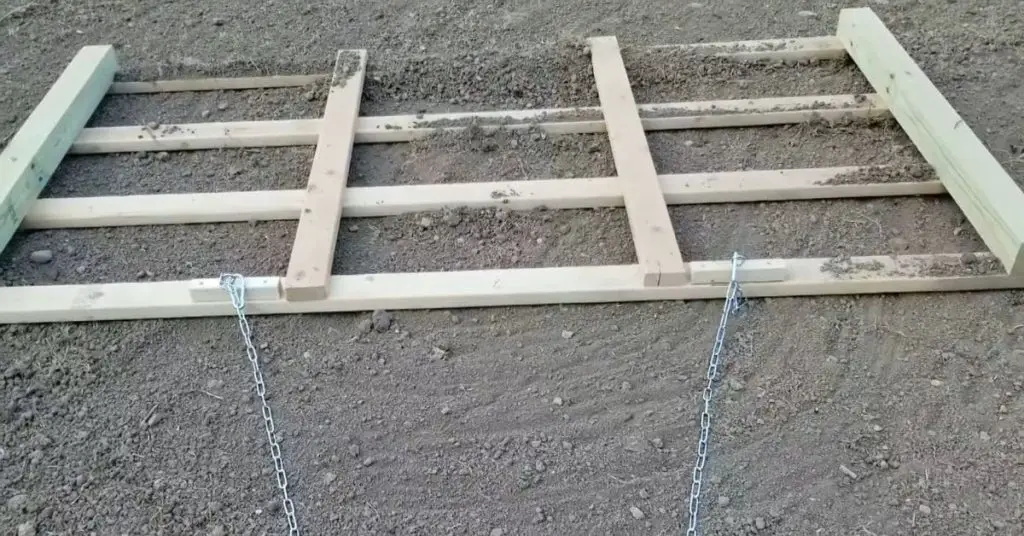
A cheap and simple way to level a trampoline on uneven or sloped ground is by placing wooden blocks under the lower side legs. You can stack the blocks on top of each other to get the desired height.
Alternatively, you can place the blocks on the ground and put the trampoline legs on them. To make sure it’s secure, you can use clamps or other methods to hold the legs in place.
Build a Retaining Wall to Level a Trampoline on a Slope:
Building an elevated retaining wall can be an effective solution if you want to install a trampoline on a steep hill. The retaining wall will be made on the lower side of the trampoline to level it properly.
You can use wood, rock, or soil to construct the wall, but remember to keep the height under four feet. This method will help secure your trampoline on high and steep slopes.
Springfree Levelling Trampoline:
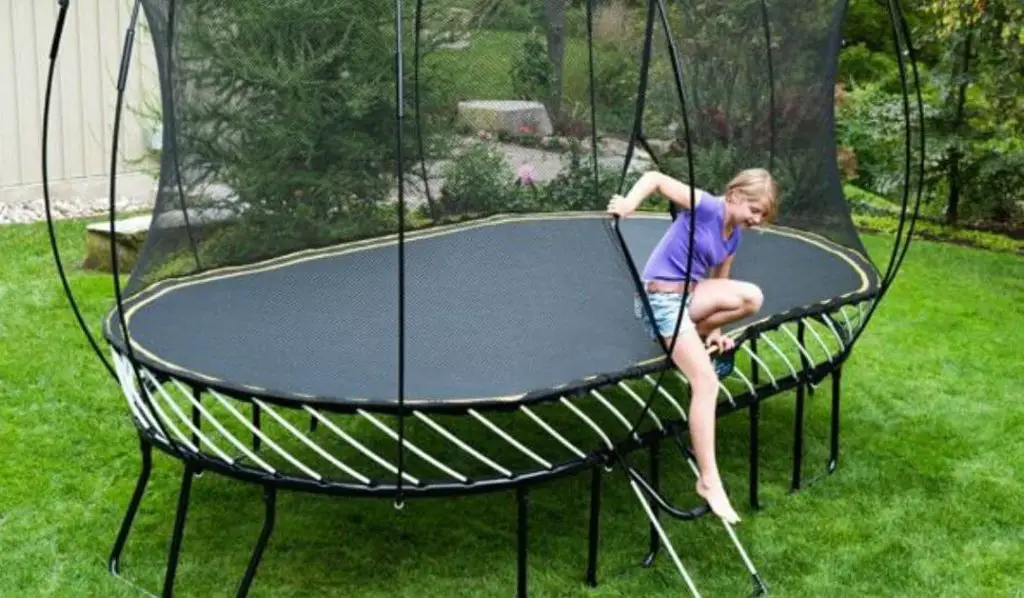
If you want to level a Springfree trampoline, the best way is to use a Springfree trampoline leveling kit. However, you can also use other methods like digging trenches or leveling blocks to level it in an uneven or sloped area.
The Benefits of Having a Level Ground for Your Trampoline
Before setting up a trampoline, it’s essential to ensure the surrounding area is safe for jumping. The space around the trampoline should be clear of any hazards that could cause injuries to the bouncers. This includes rocks, branches, and other sharp objects that might be in the way.
In addition to that, the ground on which the trampoline is placed should be level. A level surface ensures that the trampoline is stable and that bouncers can jump safely without any risks of falling.
A trampoline placed on a sloped or uneven surface can slide, causing unbalanced landings that can lead to injuries.
Moreover, the weight distribution may not be equal, which could wear out one side of the springs and mat more than the other and potentially cause it to break.
However, if the ground is not level, there are ways to level it for safe use. You can level the ground by digging a trench or using trampoline levelling blocks or kits. Leveling the ground ensures that the trampoline is stable and secure and all bouncers can jump safely.
To summarize, before setting up a trampoline, make sure to clear the area of any hazards and ensure that the ground is level. This will help ensure the safety of all users and increase the enjoyment of bouncing on the trampoline.
Creating a Safe Area Around the Trampoline
When setting up a trampoline, it is crucial to ensure that the surrounding area is safe for use. This includes clearing away any obstacles that could cause harm. For example, trees should be kept a safe distance away from the trampoline so that branches don’t get in the way while jumping. This could result in minor or serious injuries.
Additionally, it is important to keep the trampoline away from any hazards, such as pools or houses. Jumping off or into these structures can be dangerous, resulting in injury or damage to the trampoline.
The trampoline should also be kept away from any animals that may be in the yard. This is because animals can pose a risk to the person using the trampoline, or they may damage the trampoline itself.
By ensuring that the area around the trampoline is clear and free from potential hazards, you can reduce the risk of injury or damage and enjoy a safe and fun experience on your trampoline.
What Safety features should you not forget when using a trampoline?
When using a trampoline on a slope, it’s important to prioritize safety. One way to do this is to ensure that you have purchased a safety net and a spring cover for the trampoline. These safety features can help prevent injuries, especially in the case of someone falling off the trampoline.
A slope can make it more dangerous if someone falls off the trampoline as they may end up rolling down the slope and getting hurt. The safety net will help contain the jumper within the trampoline area and prevent them from falling off and rolling down the slope.
Additionally, a spring cover can prevent jumpers from landing on the springs and getting hurt. It’s important to always prioritize safety when using a trampoline to prevent accidents and injuries.
Additional Tips for Levelling a Trampoline on a Slope
If you have a sloped backyard and want to install a trampoline, there are a few additional tips to keep in mind to ensure a safe and enjoyable jumping experience.
When levelling a trampoline on a slope, there are a few additional tips you can follow to ensure maximum safety and stability. Firstly, it is recommended to place a tarp or mat underneath the trampoline to protect it from the ground. This will prevent any sharp objects or debris from damaging the trampoline and improve its stability.
Another tip is to consider building a retaining wall on the high side of the slope. This can help prevent erosion and maintain a level base for the trampoline. A retaining wall can be constructed using materials such as wood or rock or even by using the soil from the slope itself.
When building a retaining wall, it is important to ensure its height does not exceed four feet. Any higher and it may become unstable and unsafe. Additionally, make sure that the retaining wall is built securely and is able to withstand the weight and force of the trampoline and its users.
Overall, these tips can help make leveling a trampoline on a slope a safer and more enjoyable experience. By taking the time to properly level and secure the trampoline, you can ensure that it remains stable and safe for use by all.
Maintaining a Safe and Level Trampoline
Maintaining a safe and level trampoline is essential for ensuring the longevity of the trampoline and preventing injuries. Here are some additional tips for leveling a trampoline on a slope:
Use a Tarp or Mat Underneath the Trampoline:
Using a tarp or mat underneath the trampoline can help to protect it from the ground and improve stability. The tarp or mat will act as a barrier to prevent moisture from seeping into the trampoline’s frame and causing rust or corrosion.
It can also provide an extra layer of padding, which can help to absorb some of the impacts from jumping and reduce wear and tear on the trampoline mat.
Consider Building a Retaining Wall on the High Side of the Slope:
Another way to level a trampoline on a slope is to build a retaining wall on the high side of the slope. This can help to prevent erosion and maintain a level base for the trampoline.
A retaining wall can be made from a variety of materials, such as concrete blocks, wood, or bricks, and should be sturdy enough to support the weight of the trampoline.
It’s important to consult with a professional if you’re unsure about how to build a retaining wall or if you’re not confident in your construction skills.
In addition to these tips, it’s important to regularly check the trampoline for signs of wear and tear, such as loose bolts or rusted metal. Replace any damaged parts or components as needed to maintain the trampoline’s stability and safety.
Remind users to follow safety guidelines, including limiting the number of users at one time and avoiding dangerous stunts or flips. By taking these precautions, you can enjoy your trampoline safely and for years to come.
FAQs:
Q:1 Why is it important to level a trampoline on a slope?
It is important to level a trampoline on a slope for safety reasons. A sloped surface can cause the trampoline to slide, which could lead to unbalanced landings and wear on one side of the springs and mat. A level trampoline is also necessary to prevent the frame from twisting or becoming unstable.
Q:2 How do I know if my trampoline is level?
You can check if your trampoline is level by using a bubble level tool. Place the level on different points of the trampoline frame and make sure the bubble is centered. Alternatively, you can use a smartphone app that has a built-in level.
Q:3 What can I use to level my trampoline?
You can use a combination of soil, sand, gravel, or patio stones to level your trampoline. If you need to raise one side of the trampoline, you can add more material on that side. If you need to lower one side of the trampoline, you can remove material from that side.
Q:4 Can I use wood or bricks to level my trampoline?
It is not recommended to use wood or bricks to level your trampoline, as these materials can shift or rot over time and cause the trampoline to become unlevel. It is better to use stable materials such as soil, sand, gravel, or patio stones.
Q:5 Can I level my trampoline by digging into the ground?
It is not recommended to dig into the ground to level your trampoline, as this can cause the soil to become unstable and shift over time. It is better to add stable materials on top of the ground to create a level surface.
Q:6 How can I prevent my trampoline from sliding on a slope?
You can prevent your trampoline from sliding on a slope by using trampoline anchors or stakes to secure the legs to the ground. You can also build a retaining wall on the high side of the slope to prevent erosion and maintain a level base for the trampoline.
Q:7 How often should I check the level of my trampoline?
It is recommended to check the level of your trampoline at least once a year or more often if you notice any changes in the ground or if the trampoline seems unstable.
Regularly checking the trampoline for signs of wear and tear, including loose bolts or rusted metal, is also important for maintaining the trampoline’s stability and safety.
Conclusion:
In conclusion, leveling a trampoline on a slope is an important task to ensure the safety and longevity of the trampoline. A trampoline that is not level can lead to unbalanced landings, wear on one side of the springs and mat, and even accidents and injuries.
It’s important to take the necessary steps to level the ground, such as using a retaining wall or leveling kit. Additionally, using a tarp or mat underneath the trampoline can provide added stability and protect it from the ground.
Regular maintenance and safety checks are also crucial to ensure the trampoline remains level and safe to use. Regularly inspecting for wear and tear, replacing damaged parts or components, and reminding users to follow safety guidelines can help prevent accidents and injuries.
By taking these precautions and following the recommended tips, you can ensure a safe and enjoyable trampoline experience for everyone.
We hope you will be well aware of how to level a trampoline on a slope, after reading this comprehensive article. If you have any questions, feel free to comment below!

